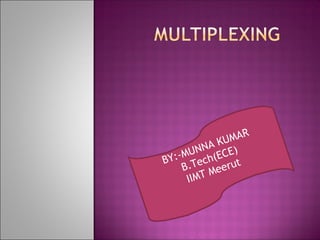
08 multiplexing
- 1. R UMA NA K E) N -MU ch(EC BY: .Te B erut e TM IIM
- 3. FDM Useful bandwidth of medium exceeds required bandwidth of channel Each signal is modulated to a different carrier frequency Carrier frequencies separated so signals do not overlap (guard bands) e.g. broadcast radio Channel allocated even if no data
- 7. AT&T (USA) Hierarchy of FDM schemes Group Supergroup 12 voice channels (4kHz each) = 48kHz Range 60kHz to 108kHz 60 channel FDM of 5 group signals on carriers between 420kHz and 612 kHz Mastergroup 10 supergroups
- 8. Multiple beams of light at different frequency Carried by optical fiber A form of FDM Each color of light (wavelength) carries separate data channel 1997 Bell Labs 100 beams Each at 10 Gbps Giving 1 terabit per second (Tbps) Commercial systems of 160 channels of 10 Gbps now available Lab systems (Alcatel) 256 channels at 39.8 Gbps each 10.1 Tbps Over 100km
- 9. Same general architecture as other FDM Number of sources generating laser beams at different frequencies Multiplexer consolidates sources for transmission over single fiber Optical amplifiers amplify all wavelengths Typically tens of km apart Demux separates channels at the destination Mostly 1550nm wavelength range Was 200MHz per channel Now 50GHz
- 10. DWDM No official or standard definition Implies more channels more closely spaced that WDM 200GHz or less
- 11. Data rate of medium exceeds data rate of digital signal to be transmitted Multiple digital signals interleaved in time May be at bit level of blocks Time slots preassigned to sources and fixed Time slots allocated even if no data Time slots do not have to be evenly distributed amongst sources
- 13. No headers and trailers Data link control protocols not needed Flow control Data rate of multiplexed line is fixed If one channel receiver can not receive data, the others must carry on The corresponding source must be quenched This leaves empty slots Error control Errors are detected and handled by individual channel systems
- 15. No flag or SYNC characters bracketing TDM frames Must provide synchronizing mechanism Added digit framing One control bit added to each TDM frame Looks like another channel - “control channel” Identifiable bit pattern used on control channel e.g. alternating 01010101…unlikely on a data channel Can compare incoming bit patterns on each channel with sync pattern
- 16. Problem - Synchronizing data sources Clocks in different sources drifting Data rates from different sources not related by simple rational number Solution - Pulse Stuffing Outgoing data rate (excluding framing bits) higher than sum of incoming rates Stuff extra dummy bits or pulses into each incoming signal until it matches local clock Stuffed pulses inserted at fixed locations in frame and removed at demultiplexer
- 18. Hierarchy of TDM USA/Canada/Japan use one system ITU-T use a similar (but different) system US system based on DS-1 format Multiplexes 24 channels Each frame has 8 bits per channel plus one framing bit 193 bits per frame
- 19. For voice each channel contains one word of digitized data (PCM, 8000 samples per sec) Data rate 8000x193 = 1.544Mbps Five out of six frames have 8 bit PCM samples Sixth frame is 7 bit PCM word plus signaling bit Signaling bits form stream for each channel containing control and routing info Same format for digital data 23 channels of data 7 bits per frame plus indicator bit for data or systems control 24th channel is sync
- 20. DS-1 can carry mixed voice and data signals 24 channels used No sync byte Can also interleave DS-1 channels Ds-2 is four DS-1 giving 6.312Mbps
- 22. Synchronous Optical Network (ANSI) Synchronous Digital Hierarchy (ITU-T) Compatible Signal Hierarchy Synchronous Transport Signal level 1 (STS-1) or Optical Carrier level 1 (OC-1) 51.84Mbps Carry DS-3 or group of lower rate signals (DS1 DS1C DS2) plus ITU-T rates (e.g. 2.048Mbps) Multiple STS-1 combined into STS-N signal ITU-T lowest rate is 155.52Mbps (STM-1)
- 25. In Synchronous TDM many slots are wasted Statistical TDM allocates time slots dynamically based on demand Multiplexer scans input lines and collects data until frame full Data rate on line lower than aggregate rates of input lines
- 27. Output data rate less than aggregate input rates May cause problems during peak periods Buffer inputs Keep buffer size to minimum to reduce delay
- 29. Two channels from cable TV provider dedicated to data transfer One in each direction Each channel shared by number of subscribers Scheme needed to allocate capacity Statistical TDM
- 30. Downstream Cable scheduler delivers data in small packets If more than one subscriber active, each gets fraction of downstream capacity May get 500kbps to 1.5Mbps Also used to allocate upstream time slots to subscribers Upstream User requests timeslots on shared upstream channel Dedicated slots for this Headend scheduler sends back assignment of future tme slots to subscriber
- 32. ADSL Link between subscriber and network Local loop Uses currently installed twisted pair cable Can carry broader spectrum 1 MHz or more
- 33. Asymmetric Greater capacity downstream than upstream Frequency division multiplexing Lowest 25kHz for voice Plain old telephone service (POTS) Use echo cancellation or FDM to give two bands Use FDM within bands Range 5.5km
- 35. DMT Multiple carrier signals at different frequencies Some bits on each channel 4kHz subchannels Send test signal and use subchannels with better signal to noise ratio 256 downstream subchannels at 4kHz (60kbps) 15.36MHz Impairments bring this down to 1.5Mbps to 9Mbps
- 38. High data rate DSL Single line DSL Very high data rate DSL
- 39. Stallings chapter 8 Web sites on ADSL SONET
